The increasing demand for faster high-throughput cell-line development and enhanced screening in the pharmaceutical field is steering research facilities and companies towards automation of existing labs.
Although robotics have been employed in some laboratories for around 40 years, their use has become more common as it assists with freeing researchers of repetitive tasks by increasing walk-away time.
Automating simple to complex assays can lower the workload of unskilled steps, including sample handling, liquid handling, centrifuging, and moving to racks. With new trends arising in robotics, there are improved and smaller robots that are simple to program. These may be easily incorporated into an integrated workcell solution.1,2
Screening of tens of thousands of clones is required in typical cell-line development to uncover the superior stable cells that generate high quantities of bioproducts.
The automation of a mammalian cell-line development workflow is displayed in Figure 1, with the automated, integrated screening of transfected cells for monoclonality, edits, and growth assessment.
This system includes multiple instruments and a collaborative robot to carry out all steps, including dispensing a single cell, screening monoclonal cells, and expanding them for additional validation assays.
This integrated system eliminates human error through increasing consistency and boosts the throughput from low to high. The cells are preserved in the best possible conditions and are monitored daily, including weekends, which significantly speeds up the production time and facilitates faster scalability.
This automated workcell solution involves all instruments that are presented in Figure 1. Other instruments may be easily added based on the complexity or requirements of the assays.3,6
Case Study: Automated Screening of CRISPR-edited Cell Lines for Monoclonality
For this case study, the integrated system incorporated a single-cell printer, Clone Select Imager – Florescence (CSI-FL), barcode readers, a liquid handler, an automated incubator, hotels, and a collaborative robot.
Utilizing the system, the transfected cells were printed into 96 and 384 well plates. Following this, they were imaged for Day 0 monoclonality assessment and monitored consistently for growth.
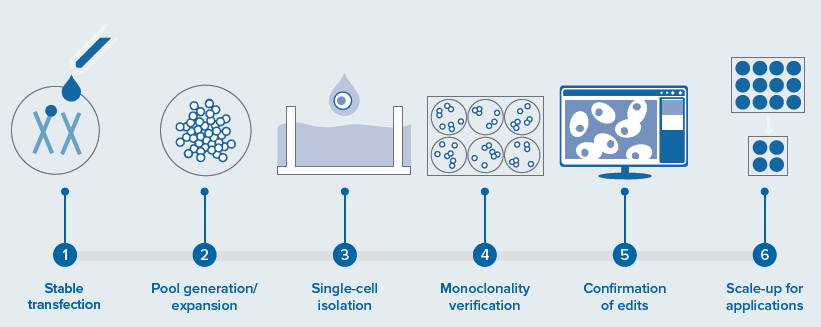
Image Credit: Molecular Devices UK Ltd
This complex workflow increased the throughput and automation of gene editing assays, screened the cells for monoclonality, and conducted the endpoint assays. This solution can be applied to cells and to develop CRISPR-edited organoids for different applications (Figure 1).
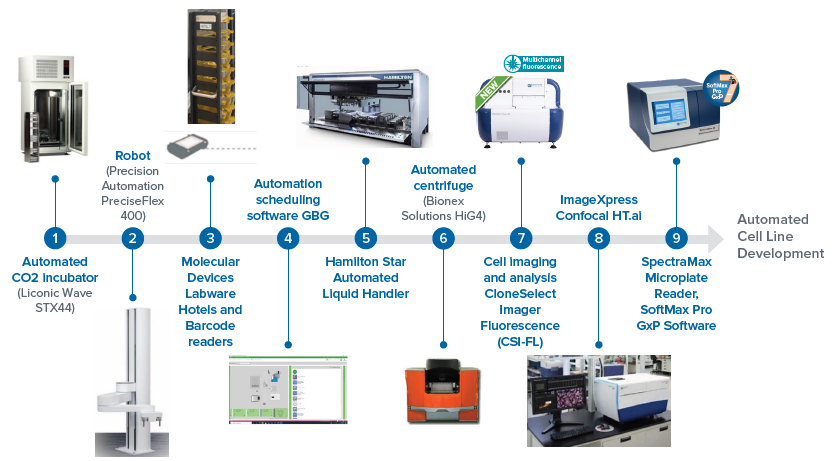
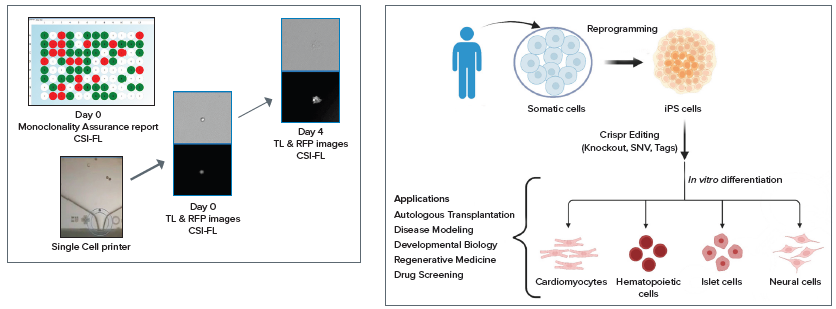
Figure 1. Workflow steps involved in a cell line development and integrated automated system for a CRISPR-edited cells/organoid screening—disease modeling. Includes various instruments and automation of different steps: the screening, and monitoring for cellular monoclonality being the most critical (performed by CSI-FL) and potential applications. Image Credit: Molecular Devices UK Ltd
Utilizing automated laboratory scheduling software (GBG, shown in Figure 2), the instrument operations were scheduled in advance to carry out the workflow steps.
CRISPR editing of the cells and maintenance were performed using a liquid handler and incubator. These cells were later single-cell dispensed into multi-well plates to develop a monoclonal cell line.
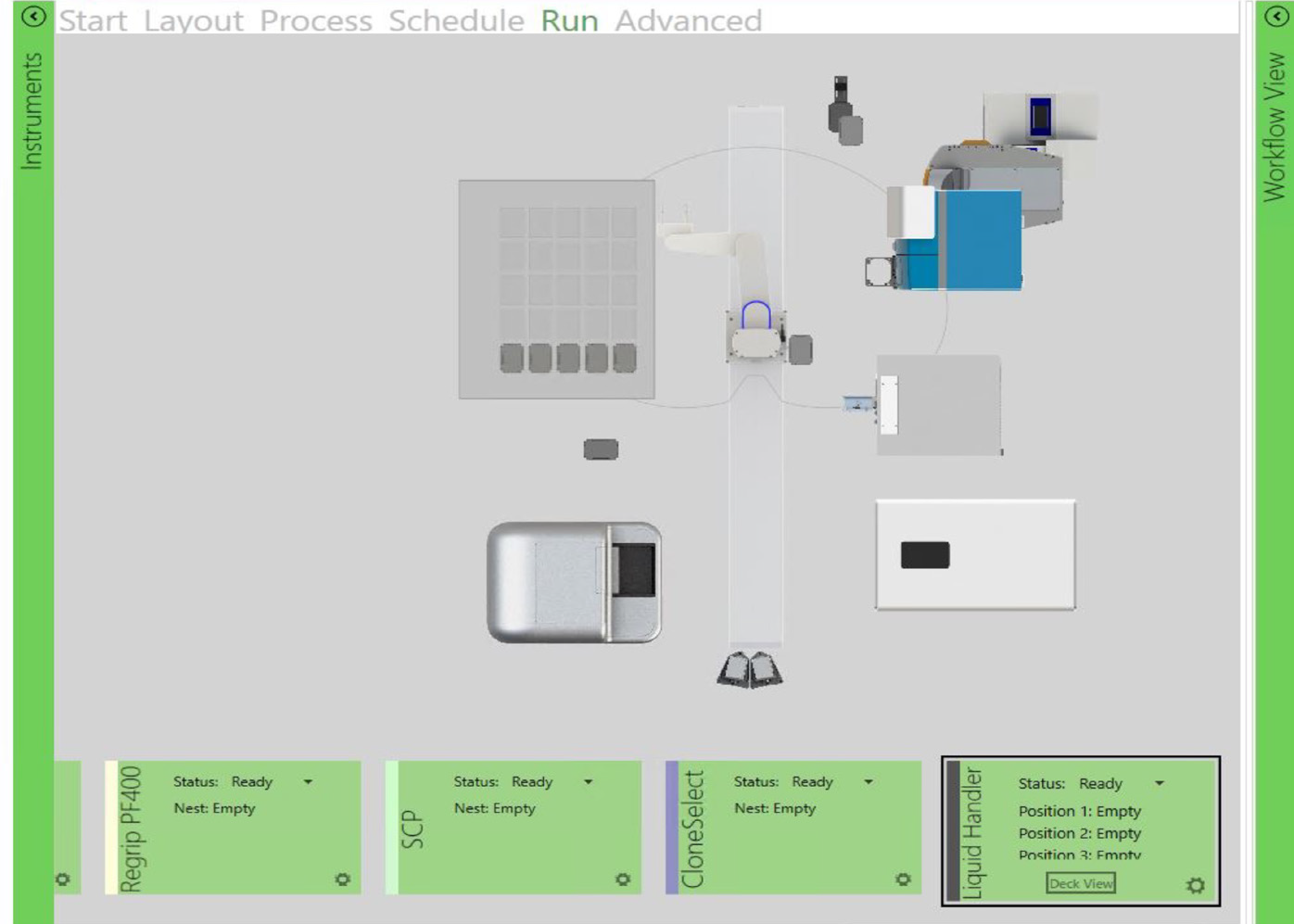
Figure 2. This virtual platform shows CSI-FL, automated incubator, liquid handler, hotel, and barcode readers. These instruments are integrated on a fully virtual environment (GBG) across a workstation to run an automated workflow. The devices were monitored in real-time and added or dropped off the system based on the workflow needs. Image Credit: Molecular Devices UK Ltd
These multiwell plates were imaged daily, from Day 0 until Day 14, via CSI-FL (see Figure 3 and Figure 4) to create a day 0 monoclonality assurance report (presented in Figure 1) and monitor each cell’s growth.
With the cells being electronically tracked, monitoring parameters were stored in plate data, such as cell confluence, cell number estimation, and growth curve.
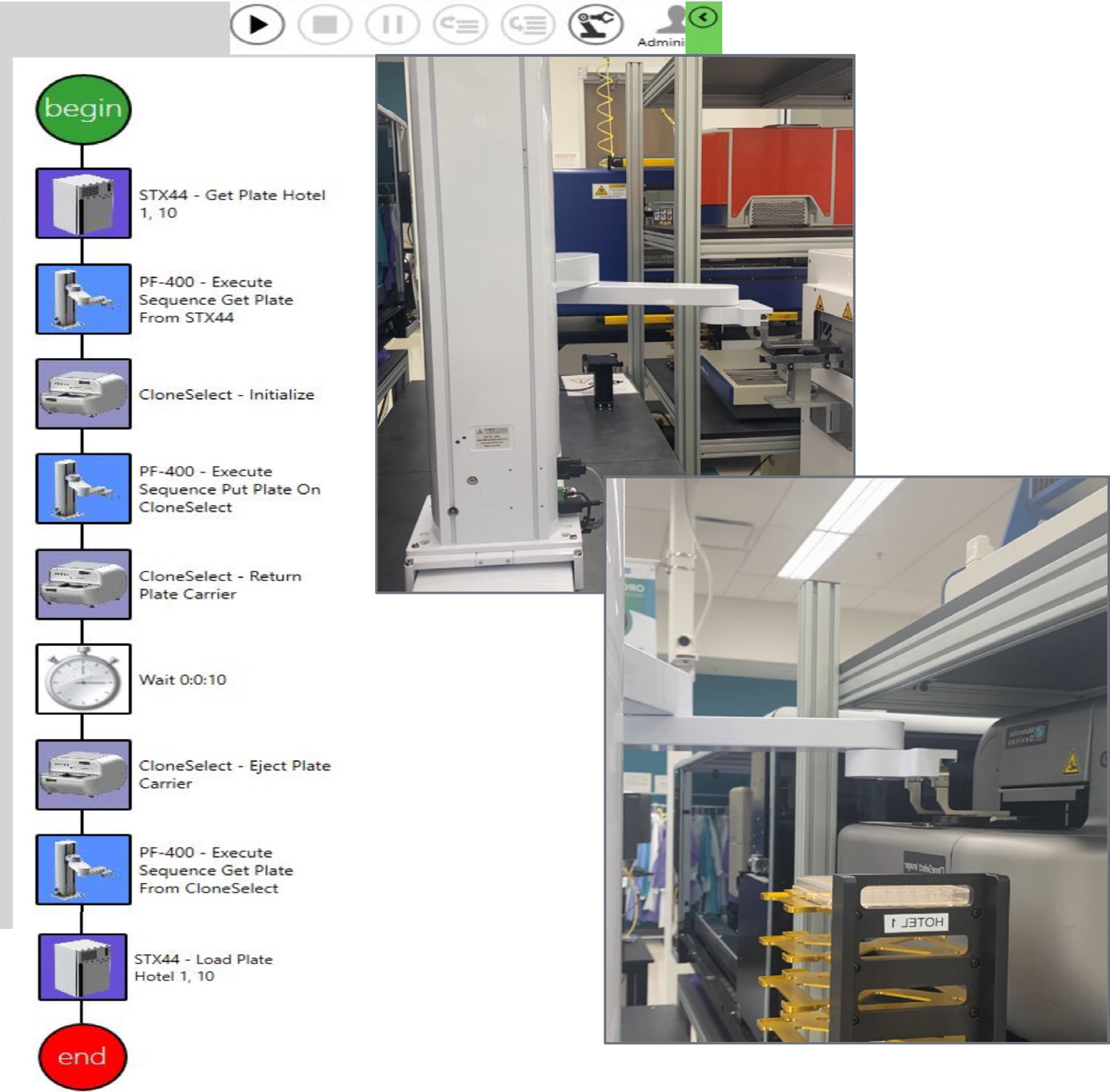
Figure 3. This sequence of steps was designed on automation software (GBG, left) to image a single cell printed 96-well plate. The path is timed/scheduled and allows imaging – incubator → imager → incubator. The top right image shows the collaborative robot picking up the 96-well plate,and the bottom right image shows the robot placing the plate in CSI-FL. Image Credit: Molecular Devices UK Ltd
The instrument objectively and quantitatively reviews cell growth and is compatible with adherant or settled suspension cell types. These include diverse cell types, such as hybridomas, IPSCs, CHO, HEK, etc.
Here, CRISPR plasmids for p53 KO (Santa Cruz Bio) were used to develop an adherant monoclonal HEK-293 cell line by transfection. The cell line produced was further subjected to endpoint assays for edit verification.7-9
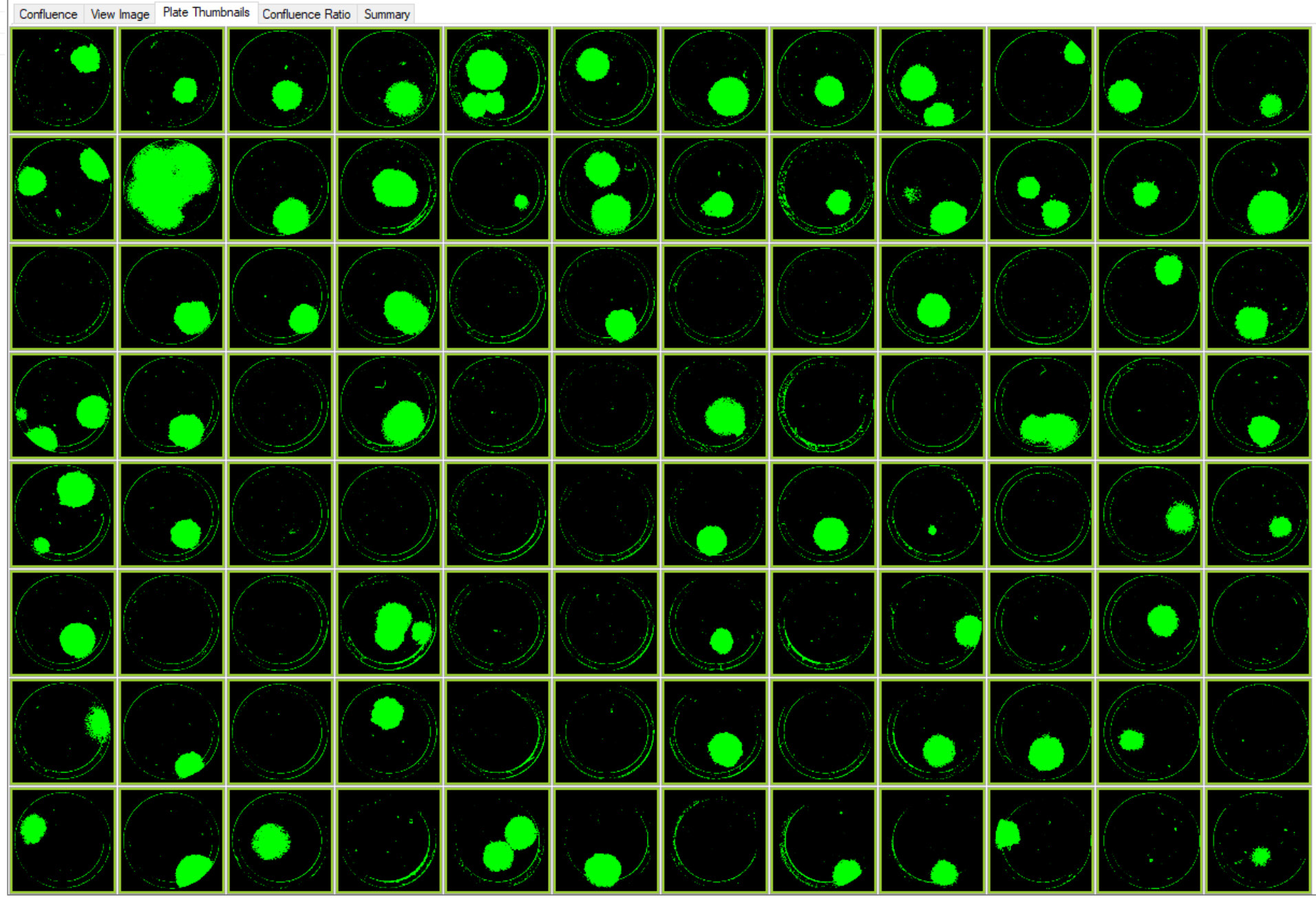
Figure 4. Images of colonies of single-cell printed CRISPR edited cells with RFP marker. This plate layout image of a 96–well Costar 3300 plate with cells on Day 9 was acquired using CSI-FL at 4X. Image Credit: Molecular Devices UK Ltd
Summary
Utilization of the automated instruments and CSI-FL enabled the edited cells to be imaged and tracked for monoclonality with ease, as well as weeks of walk-away time. The throughput, reliability, and contamination risks were substantially changed. High-quality CRISPR-edited cell lines were achieved and were utilized for end-point assays.
The automated integrated systems workflow, in combination with CSI-FL, offers a response to the ever-increasing demand to reduce timelines for cell-line development and automated solutions.
Benefits of using CSI-FL with the automated integrated systems workflow include:
- Quick scale-up acceleration
- Greater walk-away time
- Fewer redundant tasks
- Consistent processing
- Enhanced cellular monitoring
- Dynamic workflow solutions
References and Further Reading
- Lindgren, Kristina, et al. “Automation of cell line development.” Cytotechnology 59.1 (2009): 1-10.
- F. Mirasol, “The Role of Automation in Cell-Line Development,” BioPharm International 32 (1) 2019.
- Felder, RA, Boyd, JC, Savory, J, Margrey, K, Martinez, A, Vaughn, D. Robotics in the clinical laboratory. Rev Clin Lab Med 1988; 8:699–711. https://doi.org/10.1016/s0272-2712(18)30657-7.Search in Google Scholar
- Wheeler, MJ. Overview on robotics in the laboratory. Ann Clin Biochem 2007; 44:209–18. https://doi.org/10.1258/000456307780480873.Search in Google Scholar
- Lippi, G, Da Rin, G. Advantages, and limitations of total laboratory automation: a personal overview. Clin Chem Lab Med 2019; 57:802–11. https://doi.org/10.1515/cclm-2018-1323.Search in Google Scholar
- Chapman, T. Lab automation and robotics: Automation on the move. Nature 421, 661–663 (2003). https://doi.org/10.1038/421661a
- Accelerating gene edited cell lines with the CloneSelect Imager FL, Molecular Devices.
- CloneSelect Imager FL fluorescent imaging for rapid day zero monoclonality assurance, Molecular Devices.
- What is Gene Editing, CRISPR Engineering, CRISPR/Cas9 | Molecular Devices
About Molecular Devices UK Ltd
Molecular Devices is one of the world’s leading providers of high-performance life science technology. We make advanced scientific discovery possible for academia, pharma, and biotech customers with platforms for high-throughput screening, genomic and cellular analysis, colony selection and microplate detection. From cancer to COVID-19, we've contributed to scientific breakthroughs described in over 230,000 peer-reviewed publications.
Over 160,000 of our innovative solutions are incorporated into laboratories worldwide, enabling scientists to improve productivity and effectiveness – ultimately accelerating research and the development of new therapeutics. Molecular Devices is headquartered in Silicon Valley, Calif., with best-in-class teams around the globe. Over 1,000 associates are guided by our diverse leadership team and female president that prioritize a culture of collaboration, engagement, diversity, and inclusion.
To learn more about how Molecular Devices helps fast-track scientific discovery, visit www.moleculardevices.com.
Sponsored Content Policy: AZO Life Sciences publishes articles and related content that may be derived from sources where we have existing commercial relationships, provided such content adds value to the core editorial ethos of News-Medical.Net which is to educate and inform site visitors interested in medical research, science, medical devices and treatments.